The Challenger Disaster, Thirty Years Later
Thirty years ago this week, tragedy struck America's Space Program.
Thirty years ago this week, on an unusually cold Florida morning, the Space Shuttle Challenger launched into space after having seen its launch aborted several times before due to weather and ice conditions. The mission was meant to be historic since one of the crew members was Christa McAuliffe, a schoolteacher from New Hampshire who had been selected after a nationwide search to be the first “Teacher In Space.” As a result, there were televisions on in many classrooms and schools across the United States as the shuttle readied to launch. President Reagan was set to give his State of the Union later that evening, and it’s clear that the launch would have been mentioned had it gone off successfully. Instead of a successful launch, though, those who tuned into to watch, and those who were there live, became witnesses to a tragedy:
After multiple delays, Challenger blasted off on mission STS-51L at 11:38 a.m. EST on Jan. 28, 1986. It was the second of 16 missions planned for 1986 as the space agency struggled to meet a brutal schedule that included the back-to-back launches in May, five days apart, of two planetary probes from shuttles carrying complex hydrogen-fueled Centaur boosters.
The flight schedule also included a high-priority astronomy mission, the first military shuttle flight into polar orbit from Vandenberg Air Force Base in California, launch of the Hubble Space Telescope and the first fight of a journalist who would become the second so-called “private citizen” to fly in space.
The first was to be Christa McAuliffe, a New Hampshire high school teacher who won a nationwide competition to teach lessons from space. She was strapped into a seat on Challenger’s lower deck, between Ronald McNair on her left and Hughes Aircraft Co. satellite engineer Gregory Jarvis on her right.
Seated on the orbiter’s upper deck were commander Scobee, pilot Michael Smith, flight engineer Judy Resnik and Ellison Onizuka. McAuliffe, Jarvis and Smith were rookies making their first flight while the rest were shuttle veterans.
As Challenger climbed away from launch complex 39B, Scobee Rodgers and the other immediate family members looked on from the roof of the launch control center, or LCC, 3.4 miles from launch complex 39B. McAuliffe’s parents chose to watch the launching from a nearby parking lot below the Kennedy Space Center press site.
It was a cold day after a night of sub-freezing weather, but the sky was clear and Challenger put on a thrilling show as it climbed away atop a churning trail of fiery exhaust. Moments later, the crackling roar of those huge boosters reached the LCC and nearby press site.
“You can imagine, we were on top of the world, I mean, Dick and I were going fast down this highway,” Scobee Rodgers said. “We married as teenagers, he wanted to be a pilot, I wanted to be an educator, we worked together, helping each other with college, careers, two wonderful children. It was the top of our careers, the top of our lives, I mean, he is now the commander of the space shuttle!
“It’s a big deal, and I’m so proud that he is involved in the Teacher in Space program because I was a college professor at the time. I loved and thought the world of Christa McAuliffe.”
The liftoff appeared normal enough, but 73 seconds later, as the shuttle was passing through 46,000 feet at a velocity just under twice the speed of sound, the spacecraft was engulfed in a sudden maelstrom of fiery vapor and debris.
From the roof of the LCC and the nearby press site, the orbiter could not be seen, it had disappeared behind the booster exhaust plume seconds earlier as the vehicle arced away to the east. Then, suddenly, the plume appeared to expand and contrails of some sort could be seen shooting out. First one and then the other solid-fuel booster careened away from the ballooning conflagration, corkscrewing aimlessly through the sky.
Shocked onlookers knew something unusual and probably catastrophic had occurred, but it took several agonizing moments for the severity of the problem to sink in. Some began wondering if Scobee and Smith might be attempting an emergency return-to-launch-site — RTLS — abort.
NASA commentator Steve Nesbitt in mission control at the Johnson Space Center in Houston did not immediately realize what had happened as he read off trajectory data from his console’s display: “One minute 15 seconds. Velocity 2,900 feet per second (1,977 mph). Altitude 9 nautical miles. Downrange distance 7 nautical miles.”
Thirteen seconds later after the breakup began, flight director Jay Greene called flight dynamics officer — FIDO — Brian Perry over an internal audio circuit: “FIDO, trajectory…”
Perry: “Go ahead.”
Greene: “Trajectory, FIDO.”
Perry: “Flight, FIDO, filters (radar) got discreting sources. We’re go.”
Ground control officer N.R. Talbott: “Flight, GC, we’ve had negative contact, loss of downlink.”
Greene: “OK, all operators, watch your data carefully.”
Perry: Flight, FIDO, till we get stuff back he’s on his cue card for abort modes.”
Greene: “Procedures, any help?”
Unknown: “Negative, flight, no data.”
Nesbitt, sitting near Greene in mission control, then uttered the first words heard by the public in the wake of the unfolding disaster and inadvertently offered a description that would go down as one of the great understatements of the space age: “Flight controllers here are looking very carefully at the situation. Obviously a major malfunction.”
Bruce Hall, a veteran CBS News reporter, was watching McAuliffe’s parents.
“I could see them, and I could see their anxiety as it came down to the launch period and then how happy they were when they saw the actual liftoff,” he recalled. “You could see just tremendous joy in their faces. Then, when the explosion happened, I think I was like many of the veterans there, we knew immediately that this was a catastrophe. Christa McAuliffe’s parents did not know that. They thought there was a problem, but they did not have any idea at all of what had happened.”
On the roof of the launch control center, Nesbitt’s words over loud speakers hit the families hard.
“So here we are, celebrating, and then this major plummet, your grief, your shock, are numbing,” Scobee Rodgers said. “It takes you from the highest point in your life to the lowest that you never thought you could possibly reached.”
She remembers the solid rocket boosters “came screaming off in the wrong direction, and explosions. I don’t have to be told it’s a ‘major malfunction,’ I’d seen enough launches, I knew. It was a scary, terribly numbing. I couldn’t even walk down the stairs. I fell, my son reached over and helped me, I was so numb and stiff, paralyzing, from viewing that.”
Here’s video of the launch:
Like many of my generation, the Challenger disaster was an iconic event that remains memorable all these years later. Since my High School was in the middle of mid-term exams at the time, I did not see the launch live but instead found out when my Science teacher told me and a group of other students about as we happened to pass him in the hall after exams were over. Because of the exam schedule that day, I was done for the day and ended up going straight home and basically sitting in front of the television watching the replay of the launch and explosion over and over again as the broadcast networks replayed the footage much as they had replayed the footage of President Reagan being shot back in 1981. Since I wasn’t even born when NASA’s previous comparable disaster, the explosion that killed the Apollo One crew on January 27, 1967, happened and a long history of successful launches and returns had immunize the American public to the continuing dangers of space travel. In subsequent months and years, of course, we would learn about the shortcuts and missed warnings about potential danger that led to the defects that made the Challenger disaster possible. A national commission headed by Neil Armstrong and Sally Ride would investigate the matter and changes in the design of the Shuttle and the booster rockets would be mandated, and it would be more than two years before Americans returned to space with the launch of Discovery in October 1988.
All of that was in the future, though. On January 26, 1986 the nation grieved for seven lost astronauts. The State of the Union was postponed, of course, and instead President Reagan addressed the nation from the Oval Office, giving one of the most memorable speeches of his Presidency:
There would be another Shuttle lost in 2003, of course, with the loss of Columbia over Texas as it returned from orbit. On that day, though, the loss of Challenger was a shock that is still easy to remember.
Photo via Wikimedia Commons
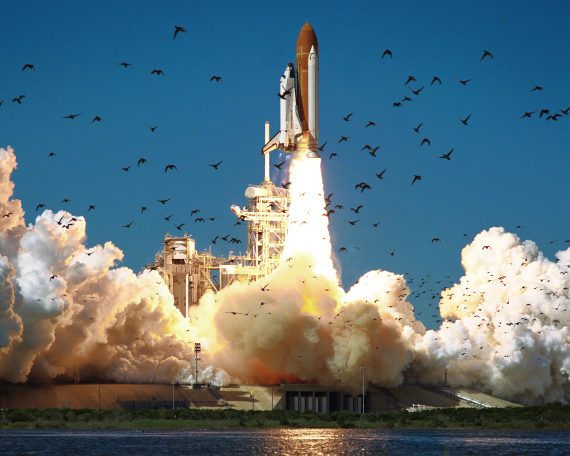

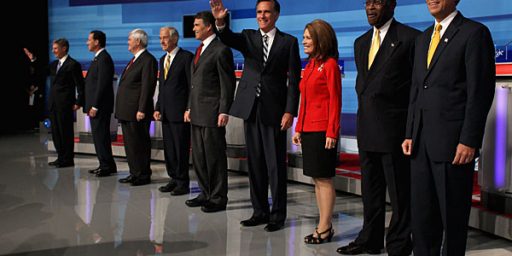
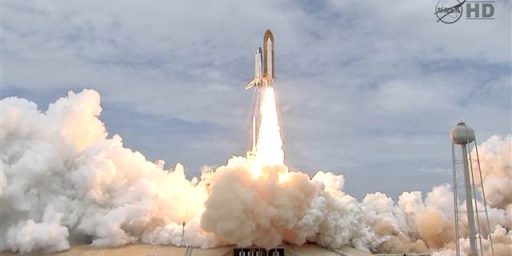
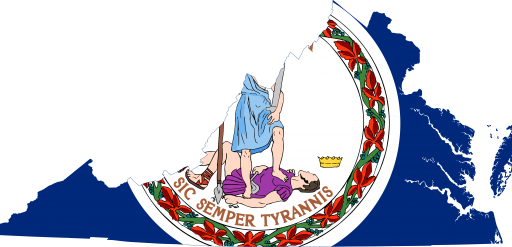
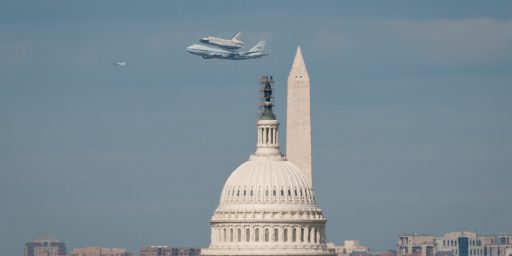
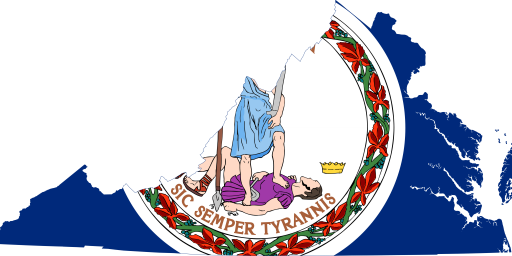
It was Obama’s fault.
An avoidable tragedy. The problems with the O-rings were a known issue, and they had no business attempting to launch under those weather conditions.
I believe it was January 28th, not the 26th. I know, as my mother remembers looking up from my 1-year bday party to see the shuttle explode on tv.
Wikipedia confirms, for what it’s worth: https://en.wikipedia.org/wiki/Space_Shuttle_Challenger.
@Neil Hudelson:
Yes, and I updated the post to reflect that.
@Neil Hudelson:
Yes, and I updated the post to reflect that.
@Neil Hudelson: Yeah, I’ve been seeing this story on a ton of sites today, but I was confused because it wasn’t today.
I remember it very well, I was actually sick at home. Nothing to do for a kid but watch TV.
It’s one of those events that you remember exactly where you were and what you were doing when it happened. I watched the video just now, and it still gave me a jolt when the shuttle exploded.
What, no mention of Richard Feynman? He basically dragged the entire panel into realizing it wasn’t an engineering problem but a human problem that had doomed the flight. Remember Morton Thiokol and the “take off your engineering hat and put on your management hat”?
Basically, Mama Nature doesn’t give a crap about PR or What Wall Street thinks.
Has it been 30 years? I remember it so clearly. I was stationed at Eglin AFB FL at the time and the news swept through the office around noon that day. Everybody was stunned.
Hard to believe it’s been 30 years. I watched the launch on TV from my office in the flight simulator building at NAS Jax then ran to the roof to see if I could see it but by the time I got there it was gone.
The next day the Challenger jokes were already circulating.
I was in Air Force basic training. A couple of my fellow trainees had gone to the personnel section for something and it was on all the TVs there. My response was basically, “Wow, that’s terrible,” but I was still so stressed by basic training that I didn’t really realize the horror of the accident until later.
@grumpy realist:
I vividly remember Feynman dropping an o-ring into a beaker of cold water and the o-ring cracking.
Another thing I remember was all the conspiracy theories–pre-Internet–that sprang up about the remains of the astronauts and their disposition.
@grumpy realist:
Nah, someone who knew about the faulty O-rings put a bug in Feynman’s ear and he worked it out, then brought it up at the commission. Later, he expressed some annoyance at being manipulated behind the scenes.
Was that live video from a local NBC station in Florida? Other than CNN I did not think any network was showing it live that morning. Sadly they thought the launches had become too routine.
Ironically, my boss had a trip to Washington planned for the week following the launch. The purpose of the trip was to discuss the winner of the first NASA Quality and Productivity Award.
January is a bad month. We had the Apollo 1 fire on January 27, 1967; Challenger; and the Columbia disaster on February 1, 2003.
They didn’t learn. Columbia was destroyed because, once again, they engaged in groupthink and proclaimed everything safe.
I was about 10 or 11 when this happened growing up in the wonderful 80’s where everything was great. 1986 was a reality check for me in that this was so shocking to a 5th grader along with the Chernobyl disaster.